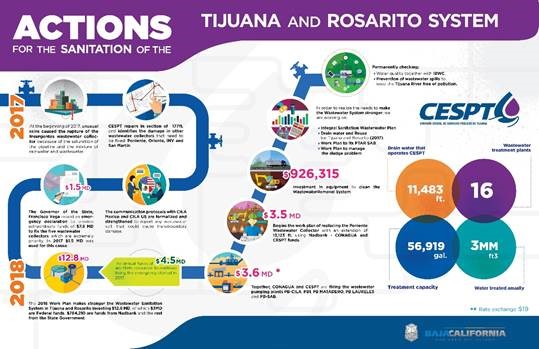September 13, 2018
On September 5th, the Chamber hosted a Good Government Speaker Series featuring the Director of Baja California’s State Commission of Public Services in Tijuana, German Lizola. The event provided an opportunity to learn about the Commission’s efforts to prevent sewage spills into the Tijuana River Watershed and improve Tijuana and Rosarito’s sewage and sanitation systems.
Following the rupture of a wastewater collector in Tijuana due to unusual rain and saturation of the pipeline, CESPT has identified other damaged wastewater collectors and repaired 4 kilometers of pipelines in Tijuana. In addition, communication protocols with the U.S. and Mexican sections of the International Boundaries and Water Commission (IBWC) were strengthened and emergency protocols were created to report any future transboundary wastewater spills.
Baja California Governor, Francisco Vega, issued a state of emergency to designate additional $7.8 M in funds to repair five wastewater collectors. The work started after the spill and have continued in 2018. This year’s work plan contemplates an investment of $12.8 M of which $3M are Mexican Federal Funds, $784,210 were funds provided by the North American Development Bank (NADBank), and the rest were provided by Baja California’s State Government. Together, the Mexican National Commission of Water (CONAGUA) and CESPT work on repairs, maintenance and improvements to wastewater pumping plants PB-CILA, PB1, PB Matadero, PB Laureles, PB-SAB, replacement and extension of the Poniente Wastewater Collector, and equipment to clear the wastewater removal system. A total of $14.5 M have been invested in collector restoration and water treatment projects under CESPT’s purview. Director Lizola highlighted that the wastewater collectors operate under capacity with no risk of overflowing, and last year’s major spills were caused after unusual heavy rain. He further explained that there is still much to be done, including the repair or replacement of the largest sewage treatment plant. The San Antonio de los Buenos plant upgrade is estimated at $247M and contemplates a new activated sludge facility. Other issues originate from an aging and deteriorating sewage infrastructure that has failed to keep up with the increase of population and caused cross border spills. When asked about major challenges, Lizola mentioned that many of the projects remain unfunded.
Looking ahead, one of the projects that has gained much attention is the collection and treatment of wastewater from La Morita and Arturo Herrera water treatment plants in Tijuana for agricultural irrigation in Valle de las Palmas and Valle de Guadalupe. The project has been awarded to an Israeli company which will take care of water collection, treatment and redirection. This project is estimated to take two years to be completed. In addition, CESPT is exploring the possibility of selling treated water to U.S. companies to satisfy the demand of water on the U.S. side of the border.
When questioned about what is needed for the Commission to continue working toward the prevention of spills and improvement of the sanitation system, Lizola highlighted the need for funds to continue maintenance and improvements, as well as projects and incentives to increase the use of recycled water by local businesses and government agencies (only 6 percent of treated water is used in Tijuana). Furthermore, Lizola shared plans to brief the incoming Mexican administration on the situation and the region’s needs to continue to prioritize related projects. He closed the meeting by stating the Commission’s commitment in procuring funds to continue working to minimize transboundary pollution and water deficit in the region.
To download CESPT’s full presentation (available only in Spanish), please click here.
